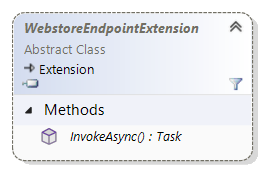WebstoreEndpointExtension reference
Sana.Extensions.Http.WebstoreEndpointExtension is an abstract class that allows a developer to handle HTTP requests in Sana Commerce. It works similar to HTTP middleware in .NET.
The addon can process the URL with the following pattern: /api/addon/{AddonId}/{*endpoint-specific-path} where:
/api/addonis a constant value,/{AddonId}is an addon identifier fromsanamanifest.xmlfile,- the rest of URL will be passed to
WebstoreEndpointContext.Request.Pathproperty to be handled inInvokeAsyncmethod.
For example, we have the addon with identifier "TestPaymentModules" and want to handle URL "/test". So, the result URL will be /api/addon/TestPaymentModules/test.

Methods
InvokeAsync
The InvokeAsync method is responsible for handling an HTTP request and providing an HTTP response.
This method takes the following arguments:
context- an instance of WebstoreEndpointContext with HTTP and webstore related information;next- contains the delegate of theInvokeAsyncmethod of the next endpoint extension;cancellationToken- an HTTP request cancellation token.
Sana calls the InvokeAsync method for each WebstoreEndpointExtension in addon one by one.
The endpoint extension can delegate request processing to the next handler available in the next argument.
If no endpoint can handle the request, then Sana will return a 404 status code with an empty response.
The method is called by Sana asynchronously, so you may use async/await here in case
you need to access any external resources in an asynchronous way.
Example:
public override Task InvokeAsync(WebstoreEndpointContext context, Func<Task> next, CancellationToken cancellationToken)
{
if (string.IsNullOrEmpty(context.Request.Headers["Authorization"]))
{
context.Response.StatusCode = (int)HttpStatusCode.Unauthorized;
context.Response.Headers.WWWAuthenticate = "Basic";
return Task.CompletedTask;
}
if (context.Request.Path.StartsWith("/test"))
{
return context.Response.WriteAsync("ok", cancellationToken);
}
// Call the next endpoint/delegate in the pipeline
return next();
}